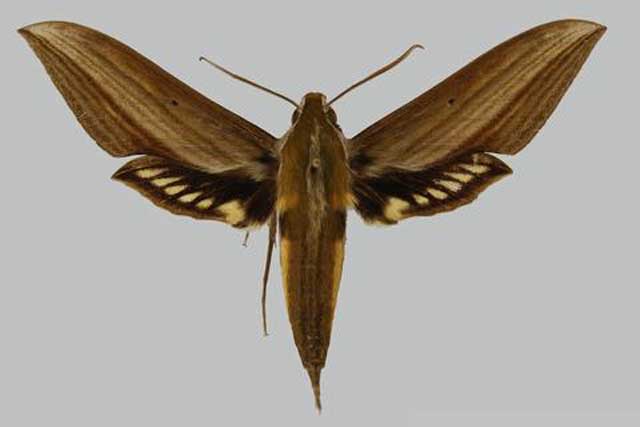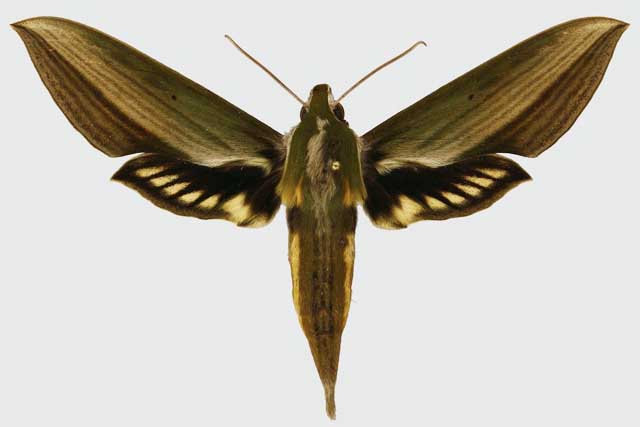Xylophanes barbuti
Updated as per http://sphingidae.myspecies.info/taxonomy/term/245/media
Xylophanes barbuti
zail-AH-fan-eesMBAR-but-eye or
zye-LAH-fan-eesMBAR-but-eye
Haxaire & Eitschberger, 2007

Xylophanes barbuti, male, Courtesy of Jean Haxaire,
as per Creative Commons at http://sphingidae.myspecies.info/taxonomy/term/245/media
This site has been created by Bill Oehlke. Comments, suggestions and/or additional information are welcomed by Bill.
TAXONOMY:
Family: Sphingidae, Latreille, 1802
Subfamily: Macroglossinae, Harris, 1839
Tribe: Macroglossini, Harris, 1839
Genus: Xylophanes Hubner [1819] ...........
Species: aristor (Boisduval, 1870)
|
DISTRIBUTION:
Xylophanes barbuti
(wingspan: males: 84-93mm; females: ) flies in
Ecuador: Loja: Road from Loja to Catamayo, km. 19, and
Peru: Amazonas: Route Leimebamba to Cajamarca.
A grey band, widening only at the juncture of the thorax and abdomen, runs from the top of the thorax to the tip of the abdomen.
On the abdomen the grey band is outwardly traced with thin black strips and inwardly split by a series of thin black segments.
The region between the costa and the first pm line is dull grey-green or grey-brown. The cell spot is distinct and black but quite small.
Between the first and fourth pm line (widest and darkest) there is a light coloured band, hosting two much thinner pm lines.
There are three dark pm lines remaining on a brown background, whether the specimen showed a green or brown upper third of the wing.
The hindwing is black with clearly divided cream-coloured teeth.
I suspect this species flies in the dry regions of southeastern Ecuador: Loja and northwestern Peru: Amazonas.
FLIGHT TIMES:
Xylophanes barbuti probably broods continuously. A specimen was taken in Loja ecuador in February.
ECLOSION:
Pupae probably wiggle to surface from subterranean chambers just prior to eclosion.

Xylophanes barbuti, female, Route Leimebamba to Cajamarca, Amazonas, Peru,
courtesy of Jean Haxaire, as per
Creative Commons at http://sphingidae.myspecies.info/taxonomy/term/245/media
SCENTING AND MATING:Females call in the males with a pheromone released from a gland at the tip of the
abdomen. Males come in to lights very readily, but females are seldom taken in that way.
EGGS, LARVAE, PUPAE:
Larvae possibly feed on Psychotria panamensis and Psychotria nervosa
of the Rubiaceae family and on
Pavonia guanacastensis of the Malvaceae family.
Moths emerge approximately one-two months after larvae pupate.
Use your browser "Back" button to return to the previous page.
Goto Main Sphingidae Index
Goto Macroglossini Tribe
Goto Central American Indices
Goto Carribean Islands
Goto South American Indices
Goto U.S.A. tables
The pronunciation of scientific names is
troublesome for many. The "suggestion" at the top of the page is
merely a suggestion. It is based on commonly
accepted English pronunciation of Greek names and/or some
fairly well accepted "rules" for latinized scientific names.
The suggested pronunciations, on this page and on other pages,
are primarily put forward to assist those who hear with internal
ears as they read.
There are many collectors from different countries whose
intonations and accents would be different.
Jean Marie Cadiou writes, "When I say "Xylophanes" in English I
pronounce it something like "Zailophanees", with the emphasis on the
"o". The French pronounce it differently, something like
"Kzeelophaness" with no emphasis, and the Germans yet in a
different way..."
In Greek myth, Phanes is the golden winged Primordial Being who
was hatched from the shining Cosmic Egg that was the source of the
universe. He personifies light emerging from chaos.
"Xylo" is the Greek word for wood.
The specimen type for the genus
Xylophanes is Xylophanes anubus. Perhaps ? when Hubner
examined this species, the yellow-orange and brown tones of the
forewings suggested wings of wood.
The species name "barbuti" is honourific for Barbut.

